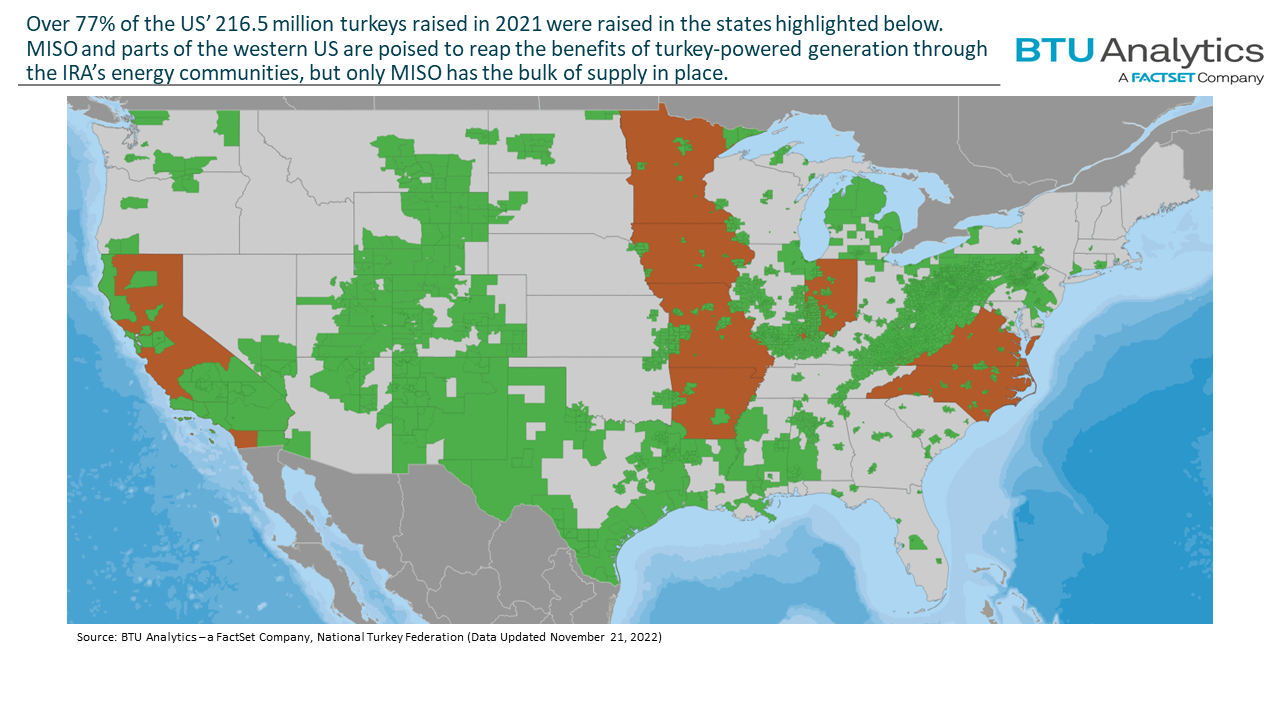As we venture further into the heart of the holiday season, Americans prepare to, once again, switch the nation’s MVB (Most Valuable Bird) from the illustrious bald eagle to the delectable domestic turkey. However, while most of what has been published on our new national bird has largely been about the price of these golden geese increasing some 11% YoY, us at BTU wanted to add our unique blend of energy-focused analysis to the veritable feast of turkey-related content that’s likely been gobbling up your news feeds the past few weeks. With that in mind, today’s Energy Market Insight will not focus on how prices could jeopardize the US’ appetite for turkey, but on how America’s (temporarily) favorite bird could revolutionize our nation’s fastest growing renewable energy source: wind.
BTU has written extensively on the Inflation Reduction Act (IRA) since its passing, primarily focusing on its creation of Energy Communities (see Parts One, Two, and Three for additional analysis on Energy Communities). Shown in the graphic below, the IRA has created a vast number of energy communities, some of which have already drawn investment for renewable energy projects. In Midcontinent ISO (MISO) alone, there are more than 250 million acres of land that qualify as energy communities and around 10 GW of proposed wind capacity in the queue.
 However, what the map above fails to include is any mention of the top eight turkey raising states in the US. As seen in the graphic below, five of the top eight turkey raising states fall under MISO. Together, those five states raised over 116 million birds in 2021, or 54% of all birds raised in the US that year.
However, what the map above fails to include is any mention of the top eight turkey raising states in the US. As seen in the graphic below, five of the top eight turkey raising states fall under MISO. Together, those five states raised over 116 million birds in 2021, or 54% of all birds raised in the US that year.
 With many of the ~2,500 farms that raised the US’ 216.5 million domesticated turkeys in 2021 existing within MISO, and with MISO’s unrivaled availability of energy communities, one must ask the question: does the IRA incentivize the development of some kind of turkey-based renewable energy technology? Yes. Yes it does. “But that’s ridiculous,” you might say. Well, is it?
With many of the ~2,500 farms that raised the US’ 216.5 million domesticated turkeys in 2021 existing within MISO, and with MISO’s unrivaled availability of energy communities, one must ask the question: does the IRA incentivize the development of some kind of turkey-based renewable energy technology? Yes. Yes it does. “But that’s ridiculous,” you might say. Well, is it?
Wind turbines have become taller and taller over the years, with onshore turbines reaching nearly 308 feet as of 2021. The diameter of the rotor has gotten larger too, with the current average rotor diameter being 418 feet. This is because the higher you go and the wider your rotor’s diameter, the more wind you can capture to turn your turbine and generate electricity. Despite these advances in technology and design, current onshore wind turbines only operate at ~42% of nameplate capacity and generate around 3 MW of power. However, turkeys, assuming sustained flight at their top speed of 50 mph, could produce so much more. Picture a rafter or gang of turkeys tethered to one of the rotor’s blades, flying at 50 mph and whiffling on the upside-down portion of their giant circles. Think of how efficient MISO’s grid would be with this reliable turkey-flight-powered generation! However, despite this impressive innovation, BTU does not include any turkey-powered generation in its forecasts.
We at BTU hope you have a happy Thanksgiving and that you enjoyed this fun, Thanksgiving-themed Energy Market Insight. If you are interested in learning more about BTU’s other (turkey-free) power offerings, analysis, and data, please fill out this contact form and include “US Power Brief” in the text box at the bottom of the page.








